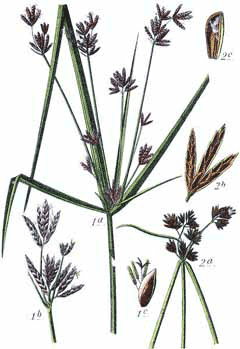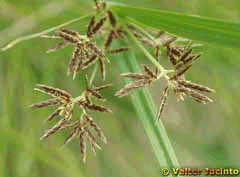 |
|
http://commons.wikimedia.org/wiki/File:Cyperaceae_spp_Sturm3.jpg |
 |
| http://www.flickr.com/photos/valter/ |
Translate this page:
Summary
Physical Characteristics

 Cyperus longus is an evergreen Perennial growing to 1.2 m (4ft) by 2 m (6ft 7in) at a fast rate.
Cyperus longus is an evergreen Perennial growing to 1.2 m (4ft) by 2 m (6ft 7in) at a fast rate.
See above for USDA hardiness. It is hardy to UK zone 7. It is in leaf all year, in flower from August to September. The species is hermaphrodite (has both male and female organs).
Suitable for: light (sandy), medium (loamy) and heavy (clay) soils. Suitable pH: mildly acid, neutral and basic (mildly alkaline) soils. It cannot grow in the shade. It prefers moist or wet soil and can grow in water.
UK Hardiness Map
US Hardiness Map
Synonyms
Plant Habitats
Pond; Bog Garden;
Edible Uses
Edible Parts: Root
Edible Uses: Condiment
Tuber - used as a spice in soups, pies and sweets[5, 183].
References More on Edible Uses
Medicinal Uses
Plants For A Future can not take any responsibility for any adverse effects from the use of plants. Always seek advice from a professional before using a plant medicinally.
Aromatic Tonic
The root is an aromatic tonic[4]. It was at one time considered to be a good stomachic and useful in the first stages of dropsy, but it has now fallen into disuse[4, 238].
References More on Medicinal Uses
The Bookshop: Edible Plant Books
Our Latest books on Perennial Plants For Food Forests and Permaculture Gardens in paperback or digital formats.

Edible Tropical Plants
Food Forest Plants for Hotter Conditions: 250+ Plants For Tropical Food Forests & Permaculture Gardens.
More

Edible Temperate Plants
Plants for Your Food Forest: 500 Plants for Temperate Food Forests & Permaculture Gardens.
More

More Books
PFAF have eight books available in paperback and digital formats. Browse the shop for more information.
Shop Now
Other Uses
Basketry Essential Paper Weaving
The leaves are used in basketry and for weaving hats, matting etc[100]. The root and stem have the scent of violets and are used in perfumery[4, 46, 61, 245]. The aroma becomes more pronounced when the root has been dried and left to age[245]. A fibre obtained from the plant is used in paper making[100].
Special Uses
Scented Plants
References More on Other Uses
Cultivation details
Prefers a moist sandy loam[95, 117]. Succeeds in any good garden soil so long as it does not dry out[162], it also grows well in up to 30cm of water[200]. Plants are hardy to about -15°c[200]. A very ornamental plant[1], though it can spread freely at the roots when well-suited[233]. Galingale was one of the favourite spices of the medieval kitchen and was an ingredient of 'pokerounce', a kind of medieval cinnamon toast[183]. It is rarely used at present. Both the root and the stem have a sweet moss-like perfume, resembling that of the violet but not so pure. The aroma becomes more fragrant with age[245].
References Carbon Farming Information and Carbon Sequestration Information
Temperature Converter
Type a value in the Celsius field to convert the value to Fahrenheit:
Fahrenheit:
The PFAF Bookshop
Plants For A Future have a number of books available in paperback and digital form. Book titles include Edible Plants, Edible Perennials, Edible Trees,Edible Shrubs, Woodland Gardening, and Temperate Food Forest Plants. Our new book is Food Forest Plants For Hotter Conditions (Tropical and Sub-Tropical).
Shop Now
Plant Propagation
Seed - surface sow in the spring and keep the compost moist[164]. The seed usually germinates in 2 - 6 weeks at 18°c[164]. Prick out the seedlings into individual pots as soon as they are large enough to handle. Grow on for their first winter in a greenhouse and plant them out in late spring after the last expected frosts. Division in spring or autumn. Division is simple at almost any time of the year, so long as the roots are not allowed to become dry. Plant them out straight into their permanent positions.
Other Names
If available other names are mentioned here
Native Range
TEMPERATE ASIA: Oman, Saudi Arabia, Yemen, Afghanistan, Cyprus, Iran, Iraq, Israel, Jordan, Lebanon, Syria, Turkey, Armenia, Azerbaijan, Georgia, Russian Federation (Dagestan), Kazakhstan, Kyrgyzstan, Turkmenistan, Uzbekistan TROPICAL ASIA: India (northwest), Nepal, Pakistan EUROPE: United Kingdom, Austria, Switzerland, Germany, Hungary, Slovakia, Russian Federation (Astrakhan), Ukraine (Krym), Albania, Bulgaria, Bosnia and Herzegovina, Greece (incl. Crete), Croatia, Italy (incl. Sardinia, Sicily), Montenegro, Romania, Serbia, Slovenia, Spain (incl. Baleares), France (incl. Corsica) AFRICA: Cabo Verde, Spain (Canarias), Portugal (Madeira Islands), Algeria, Egypt, Morocco, Ethiopia, Somalia, Chad, Kenya, Tanzania, Uganda, Cameroon, Benin, Burkina Faso, Mali, Niger, Nigeria, Senegal, Togo, South Africa (Eastern Cape, KwaZulu-Natal, Mpumalanga)
Weed Potential
Right plant wrong place. We are currently updating this section.
Please note that a plant may be invasive in one area but may not in your area so it's worth checking.
Conservation Status
IUCN Red List of Threatened Plants Status :

| Related Plants
|
| Latin Name | Common Name | Habit | Height | Hardiness | Growth | Soil | Shade | Moisture | Edible | Medicinal | Other |
| Cyperus aristatus | Bearded nutsedge | Perennial | 1.5 |
5-10
| | LM | N | MWe | 2 | 0 | 2 |
| Cyperus articulatus | Jointed flatsedge, Priprioca, Piripiri | Perennial | 1.8 |
10-12
| F | LMH | N | MWeWa | 1 | 4 | 2 |
| Cyperus cephalotes | Bhada, Flat Sedges, Nut Sedges or Umbrella Sedge. | Perennial | 0.3 |
10-12
| F | LMH | N | WeWa | 0 | 1 | 2 |
| Cyperus distans | Slender Cyperus, Piedmont flatsedge | Perennial | 0.5 |
0-0
| | LM | N | MWe | 1 | 1 | 2 |
| Cyperus esculentus | Tiger Nut, Yellow nutsedge, Nut Grass | Perennial | 0.9 |
8-10
| F | LMH | N | MWe | 4 | 2 | 3 |
| Cyperus fendlerianus | Fendler's Flatsedge | Perennial | 1.5 |
-
| | LM | N | MWe | 2 | 0 | 2 |
| Cyperus giganteus | Piripiri, Mexican Papyrus | Perennial | 1.5 |
9-11
| F | LMH | N | WeWa | 0 | 2 | 3 |
| Cyperus papyrus | Papyrus. Papyrus sedge | Perennial | 5.0 |
9-12
| F | LMH | N | WeWa | 2 | 2 | 2 |
| Cyperus rotundus | Nut Grass | Perennial | 0.6 |
0-0
| | LM | N | MWe | 3 | 3 | 2 |
| Cyperus schweinitzii | Flatsedge, Schweinitz's flatsedge | Perennial | 0.8 |
0-0
| | LM | N | MWe | 2 | 0 | 2 |
| Cyperus setigerus | Lean flatsedge | Perennial | 1.0 |
0-0
| | LM | N | MWe | 2 | 0 | 2 |
| Cyperus tegetiformis | | Perennial | 0.0 |
-
| | LM | N | MWe | 0 | 0 | 2 |
| Cyperus textilis | Flat sedge, Basket grass, | Perennial | 1.5 |
9-12
| F | LMH | FSN | MWeWa | 0 | 0 | 4 |
| Cyperus ustulatus | | Perennial | 1.2 |
-
| | LM | N | MWe | 0 | 0 | 2 |
|
Growth: S = slow M = medium F = fast. Soil: L = light (sandy) M = medium H = heavy (clay). pH: A = acid N = neutral B = basic (alkaline). Shade: F = full shade S = semi-shade N = no shade. Moisture: D = dry M = Moist We = wet Wa = water.
Now available:
Food Forest Plants for Mediterranean Conditions
350+ Perennial Plants For Mediterranean and Drier Food Forests and Permaculture Gardens.
[Paperback and eBook]
This is the third in Plants For A Future's series of plant guides for food forests tailored to
specific climate zones. Following volumes on temperate and tropical ecosystems, this book focuses
on species suited to Mediterranean conditions—regions with hot, dry summers and cool, wet winters,
often facing the added challenge of climate change.
Read More
Expert comment
Author
L.
Botanical References
17200
Links / References
For a list of references used on this page please go here
Readers comment
| Add a comment |
|
If you have important information about this plant that may help other users please add a comment or link below. Only comments or links that are felt to be directly relevant to a plant will be included. If you think a comment/link or information contained on this page is inaccurate or misleading we would welcome your feedback at [email protected]. If you have questions about a plant please use the Forum on this website as we do not have the resources to answer questions ourselves.
* Please note: the comments by website users are not necessarily those held by PFAF and may give misleading or inaccurate information.
To leave a comment please Register or login here All comments need to be approved so will not appear immediately.
|
|